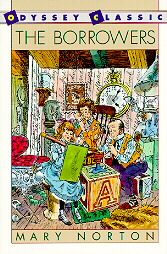


The Borrowers



by Mary Norton
illustrated by Diana Stanley
Chapter 2 Synopsis
The Borrowers
Week of June 1, 2009
Chapter 2:
Pod is out borrowing. Pod is the only one who leaves his home. He makes his way through yards and yards of dark and dusty passageway, in which he has installed wooden doors between the joists and metal gates against the mice. Only Pod knows the way through the intersecting passages to the hole under the clock and only Pod can open the gates.
Arrietty and Homily lead quiet, sheltered lives in their little apartment rooms located under the kitchen. There is a grating in the back wall which allows them to look out and see the garden, part of the graveled path and a bank where crocus blooms in spring and where later an azalea bush flowers. Arrietty spends hours watching the birds.
While Homily is making supper and awaiting Pod’s return from borrowing, Arrietty is in the sitting room. The fire has been lit and she enjoys the warmth and coziness of the room. Homily is very proud of her sitting room filled with all manner of borrowed items from the house upstairs. She papered the walls with scraps of old letters pulled from waste-paper baskets. Portraits of Queen Victoria as a girl were hung on the wall. Of course, they were postage stamps borrowed by Pod. A trinket box is used as a settle, a chest of drawers made of match boxes, a knight from a chess set. This particular piece when it went missing caused much trouble upstairs. A housemaid gave her notice over this missing piece. After she left, other things went missing, so Mrs. Driver ruled supreme in the house from that point on. Arrietty had her own library in the sitting room with miniature books, although they seemed the size of large Bibles to her. She learned to read from these books and to write by leaning sideways and copying the writings on the walls. She kept a diary and would often take it out to read a saying which would comfort her. Today it said: “You may go farther and fare worse.” Homily encouraged any form of culture. She, herself, was a poor ignorant creature and could not even say the alphabet.
DISCUSSION:
I love this chapter. It really introduces much more than the neat little things the Borrowers use (the half-scissors for cutting the potato, the book Arrietty writes in, etc.), but it introduces Arrietty's longing for freedom (she likes to sit at the grate and look outside), Homily's need to stay hidden (she never goes out, and can't understand why Arrietty likes sitting by the grate). We don't know much about Pod at this juncture.
We do get the impression that the Borrowers are all alone in the world. Pod is mentioned as being a shoemaker, but now only for his family. And there is a mention of Eggletina, but no one will tell Arrietty what happened to her, although something dreadful obviously did!
It's interesting that Arrietty can read and write, and that her mother
cannot. It doesn't say how she learned. Perhaps her dad? Her mother seems quite
in awe of her daughter being 'cultured'.
_______________________
I thought it said someplace how she learned to read but I can't remember
now. Maybe it is in another chapter.
_______________________
I was wondering about the isolation that they seem to have to live
with. And it was funny how Arrietty uses writing in her diary to get out of
chores (that would've never worked at my house). Seems very lonely though and
I wonder what caused the isolation, since apparently it wasn't always that way.
_______________________
I have been browsing again through Chapter Two. What a wealth of description
in the book. I love the way the author is introducing us to the characters bit
by bit, too.
_______________________
This chapter is very descriptive. I also felt the loneliness of Arrietty. Not so much from Homily as she seems quite content, at least at this point. She seems a bit of a nervous person. Arrietty, however, seems to want to learn and experience new things. I feel sad for her trapped in those rooms and never going out.